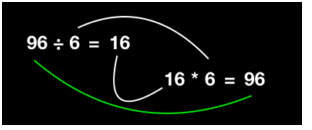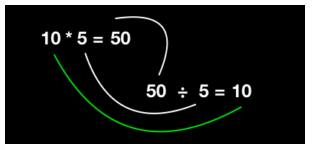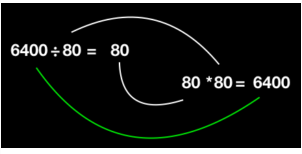Division and multiplication are very closely related. As we know that division is the inverse property of multiplication. Let a and b be two whole numbers. Dividing the number a by number b means finding the whole number when multiplied by b gives the value a and we represent it as a ÷ b = c (or) a = b * c. Division as the Inverse of Multiplication problems and theory is explained here in this article.
Example:
Divide 30 by 6 and find the inverse of multiplication?
Solution:
Given that we have to divide the value 30 by 6.
It means that finding a whole number which when multiplied by 6 gives 30. The number which divides 30 by 6 is 5. Therefore, we can write 30 ÷ 6 = 5.
The inverse of multiplication is 5 * 6 = 30
How to teach Division as the Inverse of Multiplication?
Division and multiplication are inverse operations because dividing and multiplying by the same number won’t change the original value. For example, 15 * 4/4 = 15 and 24 * 4/4 = 24. Dividing and multiplying by 4 cancels each other, so the result does not change.
See More:
Relationship between Multiplication and Division Examples
The below examples will let you know the complete details of Division as the Inverse of Multiplication concept.
Example 1:
96 rupees are equally distributed among six candidates. How much amount does each person get. Also, define the inverse of multiplication here?
Solution:
Given that the total amount of rupees = 96
No of candidates = 6
Amount of rupees each person get = 96 ÷ 6 = 16
With the division property of the above question, we get the result as 16
For the above solution, we can apply the inverse of multiplication ie., 16 * 6 = 96
Therefore division is the inverse of multiplication.

Example 2:
The cost of the pen is 10 rupees. Find the cost of 5 such boxes?
Solution:
Given that the cost of pen = 10
No of boxes = 5
Cost of 5 such boxes = 10 * 5 = 50
With the multiplication property, the result is 50
For the above solution, we can apply the division rule i.e., 50 ÷ 5 = 10
Therefore multiplication is the inverse of division.

Example 3:
The cost of 9 litres of diesel is Rs.1080. Find the cost of 1 litre of diesel?
Solution:
Given that the total cost of diesel = Rs. 1080
No of litres = 9
Cost of 1 litre of diesel = 1080 ÷ 9 = 120
With the division rule, the result is 120
For the above solution, we can apply the inverse of multiplication i.e., 120* 9 = 1080
Therefore division is the inverse of multiplication.

Example 4:
If 25 watches cost Rs. 10,500. How much will 5 watches cost?
Solution:
Given that the total cost for watches = 10,500
No of watches = 25
Cost of 5 watches = 10,500 ÷ 5 = 420
With the division rule, the result is 420
For the above solution, we can apply the inverse of multiplication i.e., 420 * 25 = 10,500
Therefore, the division is the inverse of multiplication.

Example 5:
6400 litres of milk in the tank are filled in bottles. Find the capacity of each bottle if filled in 80 bottles?
Solution:
Given that the total litres of milk = 6400
No of bottles = 80
Capacity of each bottle = 6400 ÷ 80 = 80
With the division rule, the result is 80
For the above solution, we can apply the inverse of multiplication i.e., 80 * 80 = 6400
Therefore, the division is the inverse of multiplication.

FAQs on Teaching Division as Inverse of Multiplication
1. What makes the difference between division and multiplication?
The multiplication is the product of two factors and division is to find the missing factor if the product of other fraction is known. Dividing and multiplying with the same number does not change the original value.
2. What is the example of the inverse of multiplication?
An example of inverse multiplication is
54 ÷ 6 = 9, since 9 * 6 = 54
3. How is the division as the inverse multiplication?
The division is inverse multiplication. If a given number is divided and then multiplied by the same number, you will result with the same number you started with. Multiplication comes with the opposite effect to division.